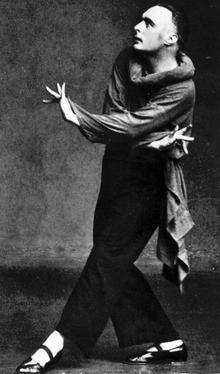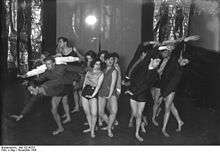Rudolf von Laban
| Rudolf von Laban | |
|---|---|
 | |
| Born |
15 December 1879 Pozsony, Kingdom of Hungary, Austro-Hungarian Empire |
| Died |
1 July 1958 (aged 78) Weybridge, England |
| Known for | Choreography, dance theory |
| Movement | Expressionist dance |
Rudolf von Laban, also known as Rudolf Laban (Hungarian: Rezső Lábán de Váraljas, Lábán Rezső, Lábán Rudolf) (15 December 1879 – 1 July 1958), was a dance artist and theorist. He is considered as one of the pioneers of modern dance in Europe, as the "Founding Father of the Expressionist Dance" in Germany.[1] His work laid the foundations for Laban Movement Analysis, Labanotation (Kinetography Laban), other more specific developments in dance notation and the evolution of many varieties of Laban Movement Study. He is considered to be one of the most important figures in the history of dance.[2]
Life and work
Rudolf Laban was born in Pozsony (now Bratislava) in 1879 in the Kingdom of Hungary, Austro-Hungarian Empire, into an aristocratic family. His father's family had come from the French nobility (De La Banne, from a French crusader stranded in Kingdom of Hungary in the 13th century) and Hungarian nobility, and his mother's family was from France. His father was a field marshal of the Austro-Hungarian Empire and the governor of the provinces of Bosnia and Herzegovina. He spent his childhood in the courtly circles of Vienna and Bratislava, as well as Bosnia and Herzegovina, in the towns of Sarajevo and Mostar.[3]
Enrolled by his father as a cadet in the Military Academy at Wiener Neustadt, he left to study architecture at the Écoles des Beaux Arts in Paris. During his stay in Paris, Laban became interested in the relationship between the moving human form and the space which surrounds it. He then moved to Munich at age 30 and under the influence of seminal dancer/choreographer Heidi Dzinkowska[4] began to concentrate on Bewegungskunst, more commonly called Ausdruckstanz, or the movement arts spending the summer months of 1913 and 1914 directing the school for the Arts at the alternative community at Monte Verita, Switzerland.
He established choreographic training centres in Zürich in 1915, and later set up branches in Italy, France, and central Europe.
One of his great contributions to dance was his 1928 publication of Kinetographie Laban, a dance notation system that came to be called Labanotation and is still used as one of the primary movement notation systems in dance. His theories of choreography and movement are now foundations of modern dance and dance notation (choreology). Later they were applied in other fields, including cultural studies, leadership development, and non-verbal communication theory.
Laban developed the art of movement choir, wherein large numbers of people move together in some choreographed manner, but that can include personal expression. This aspect of his work was closely related to his personal spiritual beliefs, based on a combination of Victorian theosophy, Sufism, and popular fin de siecle Hermeticism. By 1914 he had joined the Ordo Templi Orientis and attended their 'non-national' conference in Monte Verità, Ascona in 1917, where he directed ^The Song to the Sun^ performed on the Ticino hillside. Laban had founded a summer dance program in Ascona in 1912, which continued until 1914, when World War I broke out.


Germany
Between 1921 and 1929 he directed the Tanzbühne Laban and smaller group Kammertanzbühne Laban creating and touring dance theatre works and devising movement choirs for amateur dancers. He initiated three Dance Congresses in 1927, 1928 and 1930 to further the role of dance and the status of the dancer in Germany.
From 1930 to 1934 he was director of the Allied State Theatres in Berlin, Germany. In 1934, he was promoted to director of the Deutsche Tanzbühne, in Nazi Germany.[5]
He directed major festivals of dance under the funding of Joseph Goebbels' propaganda ministry from 1934-1936.[6] Laban even wrote during this time that "we want to dedicate our means of expression and the articulation of our power to the service of the great tasks of our Volk. With unswerving clarity our Führer points the way".[7] In 1936 Laban become the chairman of the association "German workshops for dance" and received a salary of 1250RM per month,[8] but a duodenal ulcer in August of that year bed bound him for two months, eventually leading him to ask to reduce his responsibilities to consultancy.[9] This was accepted and his wage reduced to 500RM, his employment then ran until March 1937 when his contract ended.[10] Several allegations of Laban's attachment to Nazi ideology have been made, for instance that as early as July 1933 he was removing all pupils branded as non-Aryans from the children's course he was running as a ballet director.[11] However, some Laban scholars have pointed out[12] that such words and actions were necessary for survival in Germany at that time, and that his position was precarious as he was neither a German citizen nor a Nazi party member. His work under the Nazi regime culminated in 1936 with Goebbel's banning of Vom Tauwind und der Neuen Freude (Of the Spring Wind and the New Joy) for not furthering the Nazi agenda.[13]
England
He was allowed to travel to Paris in 1937 and from there he went to England. He joined the Jooss-Leeder Dance School at Dartington Hall in the county of Devon where innovative dance was already being taught by other refugees from Germany.
He was greatly assisted in his dance teaching during these years by his close associate and long-term partner Lisa Ullmann. Their collaboration led to the founding of the Laban Art of Movement Guild (now known as The Laban Guild for Movement and Dance) in 1945 and the Art of Movement Studio in Manchester in 1946. Laban was a friend of Carl Jung and Josef Pilates (inventor of the Pilates method of physical fitness).
In 1947, he published a book Effort, Fordistic study of the time taken to perform tasks in the workplace and the energy used. He tried to provide methods intended to help workers to eliminate "shadow movements" (which he believed wasted energy and time) and to focus instead on constructive movements necessary to the job in hand. He published Modern Educational Dance in 1948 when his ideas on dance for all including children were taught in many British schools.
He died in the UK.
Among Laban's students, friends, and associates were Mary Wigman, Kurt Jooss, Lisa Ullmann, Albrecht Knust, Lilian Harmel, Sophie Taeuber-Arp, Hilde Holger, Gertrud Kraus, Gisa Geert, Warren Lamb, Elizabeth Sneddon, Yat Malmgren and Irmgard Bartenieff.
Archives
The Laban Collection in the Laban Archive at Trinity Laban Conservatoire of Music and Dance documents Laban's life and work in the 1920s-1950s. The Rudolf Laban Archive at the National Resource Centre for Dance documents his educational work in the UK and contains many of his original drawings. The John Hodgson Collection in the Brotherton Library at Leeds University holds original documents relating to Laban's career in Europe in the early twentieth century. Other archives holding material about Rudolf Laban include the Tanzarchiv Leipzig e.V., Dartington Archive and the German Dance Archives, Cologne
Works and publications
- (Undated). Harmonie Lehre Der Bewegung (German). (Handwritten copy by Sylvia Bodmer of a book by Rudolf Laban) London: Laban Collection S. B. 48.
- (1920). Die Welt des Taenzers [The world of Dancers] (German). Stuttgart: Walter Seifert. (3rd edition, 1926)
- (1926). Choreographie: Erstes Heft (German). Jena: Eugen Diederichs.
- (1926). Gymnastik und Tanz (German). Oldenburg: Stalling.
- (1926). Des Kindes Gymnastik und Tanz (German). Oldenburg: Stalling.
- (1928). Schriftanz: Methodik, Orthographie, Erlaeuterungen (German). Vienna: Universal Edition.
- (1929). "Das Choreographische Institut Laban" in Monographien der Ausbildungen fuer Tanz und Taenzerische Koeperbildung (German). Edited by Liesel Freund. Berlin-Charlottenburg: L. Alterthum.
- (1947). with F. C. Lawrence. Effort: Economy of Human Movement London: MacDonald and Evans. (4th reprint 1967)
- (1948). Modern Educational Dance. London: MacDonald and Evans. (2nd Edition 1963, revised by Lisa Ullmann)
- (1948). "President’s address at the annual general meeting of the Laban art of movement guild". Laban Art of Movement Guild News Sheet. 1 (April): 5-8.
- (1950). The Mastery of Movement on the Stage. London: MacDonald and Evans.
- (1951). "What has led you to study movement? Answered by R. Laban". Laban Art of Movement Guild News Sheet. 7 (Sept.): 8-11.
- (1952). "The art of movement in the school". Laban Art of Movement Guild News Sheet. 8 (March): 10-16.
- (1956). Laban’s Principles of Dance and Movement Notation. London: MacDonald and Evans. (2nd edition 1975, annotated and edited by Roderyk Lange)
- (1960). The Mastery of Movement. (2nd Edition of The Mastery of Movement on the Stage), revised and enlarged by Lisa Ullmann. London: MacDonald and Evans. (3rd Edition, 1971. London: MacDonald and Evans) (1st American Edition, 1971. Boston: Plays) (4th Edition, 1980. Plymouth, UK: Northcote House)
- (1966). Choreutics. Annotated and edited by Lisa Ullmann. London: MacDonald and Evans.
- (1974). The Language of Movement; A Guide Book to Choreutics. Annotated and edited by Lisa Ullmann. Boston: Plays. (American publication of Choreutics)
- (1975). A Life For Dance; Reminiscencs. Translated and annotated by Lisa Ullmann. London: MacDonald & Evans. (Original German published 1935.)
- (1984). A Vision of Dynamic Space. Compiled by Lisa Ullmann. London: The Falmer Press.
References
- ↑ Dörr, Evelyn, (2008). "Rudolf Laban: The Dancer of the Crystal", Lanham, Maryland: Scarecrow Press, page 99-101.
- ↑ Karina, Lillian & Kant, Marion, (2003) (translator: Steinberg, Jonathan). "Hitler's Dancers: German Modern Dance and the Third Reich", New York & Oxford: Berghahn Books, page viii.
- ↑ Dörr, Evelyn, (2008). "Rudolf Laban: The Dancer of the Crystal", Lanham, Maryland: Scarecrow Press, page 1-8.
- ↑ dance-archives.ac.uk
- ↑ Rudolf Laban Archived 2006-11-02 at the Wayback Machine. extensive biography from Trinity-Laban School, London.
- ↑ Manning, Susan. "Reinterpreting Laban" a review of "Body-Space-Expression: The Development of Rudolf Laban's Movement and Dance Concepts" by Vera Maletic. Dance Chronicle, Vol. 11, No. 2 (1988), pp. 315–320.
- ↑ Rudolf Laban, "Meister und Werk in der Tanzkunst," Deutsche Tanzzeitschrift, May 1936, quoted in Horst Koegler, "Vom Ausdruckstanz zum 'Bewegungschor' des deutschen Volkes: Rudolf von Laban," in Intellektuellen im Bann des National Sozialismus, ed. Karl Corino (Hamburg: Hoffmann & Campe, 1980), p. 176.
- ↑ Karina, Lillian & Kant, Marion, 2003 (translator: Steinberg, Jonathan). "Hitler's Dancers: German Modern Dance and the Third Reich", New York & Oxford: Berghahn Books, p. 244.
- ↑ Karina, Lillian & Kant, Marion, 2003 (translator: Steinberg, Jonathan). "Hitler's Dancers: German Modern Dance and the Third Reich", New York & Oxford: Berghahn Books, p. 254.
- ↑ Karina, Lillian & Kant, Marion, 2003 (translator: Steinberg, Jonathan). "Hitler's Dancers: German Modern Dance and the Third Reich", New York & Oxford: Berghahn Books, p. 256.
- ↑ Karina, Lillian & Kant, Marion (translator: Steinberg, Jonathan). "Hitler's Dancers: German Modern Dance and the Third Reich", New York & Oxford: Berghahn Books, 2003.
- ↑ Preston-Dunlop, Valerie. "Rudolf Laban An Extraordinary Life" (Dance Books, 1998) (especially Chap. 9 'The Nazification of Culture' and Chap. 10 'Survival').
- ↑ Kew, Carole. "From Weimar Movement Choir to Nazi Community Dance: The Rise and Fall of Rudolf Laban's "Festkultur"".Dance Research: The Journal of the Society for Dance Research, Vol. 17, No. 2 (1999): pp. 73–96.
External links
| Wikimedia Commons has media related to Rudolf von Laban. |
- Guide to the Rudolf Laban Icosahedron. Special Collections and Archives, The University of California Irvine Libraries, Irvine, California
- Rudolf Laban - biography from Trinity Laban site
- Limsonline Laban/Bartenieff Institute of Movement Studies - LIMS NYC
- Short biographies of Laban and some leading Laban practitioners - website of Laban Project
- EUROLAB - European Association of Laban/Bartenieff Movement Studies
- EUROLAB Certificate Programs in Laban/Bartenieff Movement Studies
- Free scores by Rudolf von Laban at the International Music Score Library Project (IMSLP)